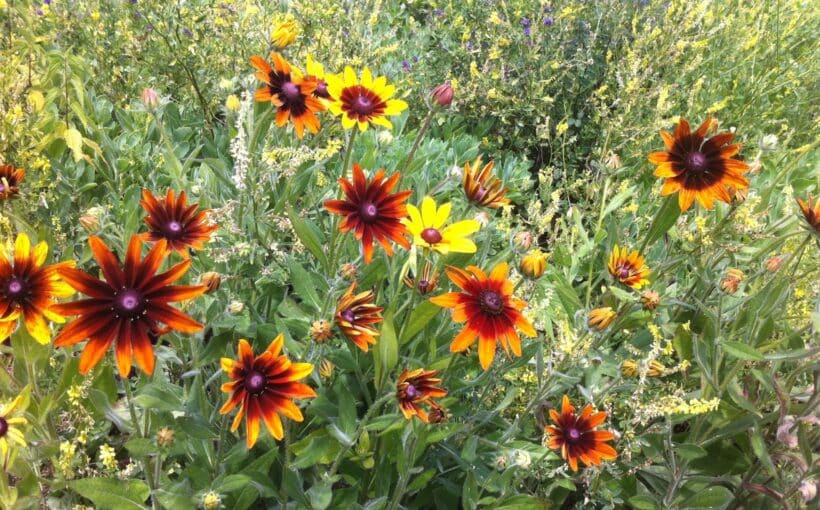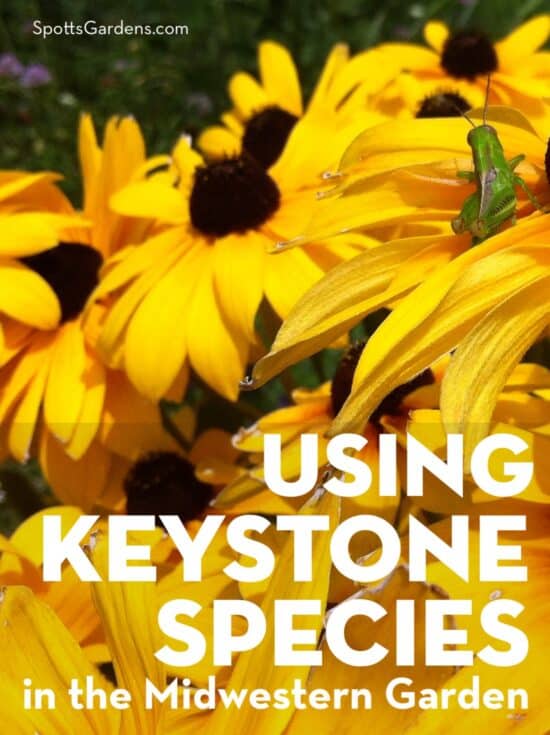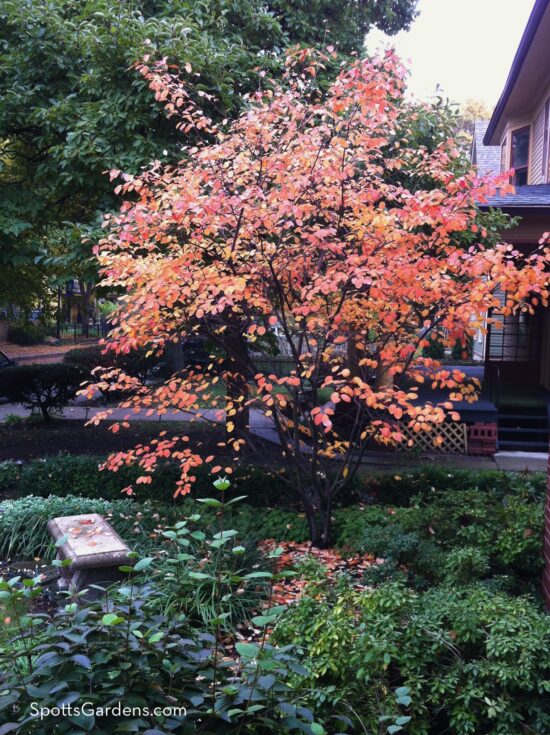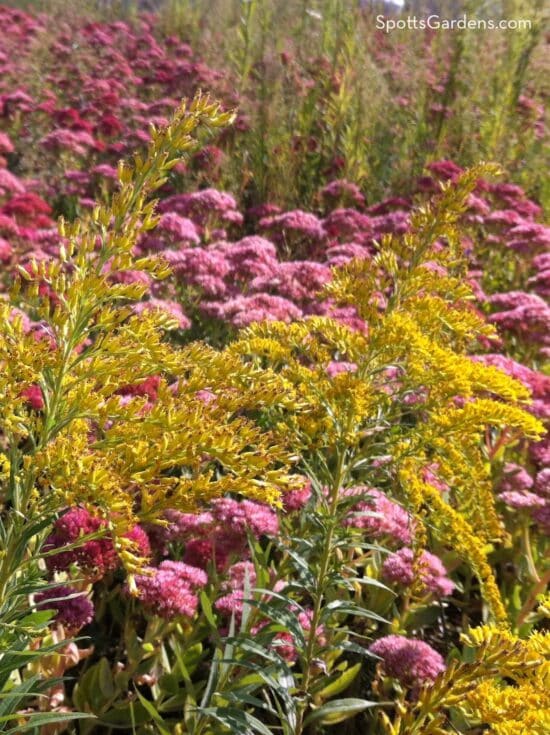Home gardens can be havens for bees, butterflies, birds, and other animals. As wildlife continues to lose habitat and pollinator populations dwindle, adding native plants to your garden can provide vital way stations for these creatures.
But some native plants have an even greater effect on our ecosystems. Adding one or more keystone species amplifies your garden’s contribution to rebuilding biodiversity!
Keystone Species and the Food Web
A keystone species is one that has an outsize effect in stabilizing an ecosystem, even though its numbers might be small.
Food webs are reliant on a large population of insects that feed other animals. Because our native insects and plants evolved together, many of those native insects feed only one species of native plants, or plants in one genus.
- Research shows that just a few specific genera of native plants form the backbone of local ecosystems.
- About 96% of terrestrial birds are reliant on insect species for food.
- Entomologist Dr. Doug Tallamy and his team at the University of Delaware found that just 14% of native plants feed 90% of moth and butterfly species.
- Horticulturist Jarrod Fowler’s research shows that between 15% and 60% of our native North American bee species eat pollen from only specific species of native plants. So about 40% of our native plants support up to 60% of our native bees.
Even if an ecosystem has huge number of different plant species, that food web will collapse if it doesn’t have keystone species. The same is true of the food webs in our gardens.
Choosing Keystone Species for Your Garden
To maximize biodiversity and make your garden’s food web as robust as possible, add at least one keystone species. Keystone species for your garden are:
- Native to your area or ecoregion. An ecoregion is an area whose ecosystems have significant similarities, including weather, seasons, soil, native species, etc.
- Appropriate for your garden’s conditions. You still have to put the right plant in the right place!
- Adaptable even to containers! Homegrown National Park takes you through how to container garden with keystone species.
So how can you find which plants are keystone species in your area?
- The National Wildlife Federation breaks out keystone species by level 1 ecoregions. Throughout this article, we’ve used NWF’s numbers for how many insects each keystone genus supports. Indiana is in level 1 ecoregion 8: Eastern Temperate Forest.
- Homegrown National Park identifies more specific areas, calling out keystone species based on level 2 ecoregions. Central Indiana is in level 2 ecoregion 8.2: Central USA Plains.
Keystone Trees and Shrubs for Indiana Gardens
We plant keystone species in every garden we design. Plants on our favorites list are native to Indiana, well-behaved enough not to rampage through the borders, and not prone to disease.
Research is continuing on whether cultivated varieties are as valuable as straight species (wild plants). But since cultivated varieties are often better sized for gardens, we’re in favor of their use where straight species may be inappropriate. Choose varieties that are as close to the form of the wild species as possible. Avoid varieties bred for the floral industry, which are often pollenless.
We look for tree species not over-represented in the urban canopy. Our Indianapolis neighborhoods already have plenty of maples, so we generally avoid adding more Acer species, even though that is a keystone genus!
Oaks (Quercus spp.)
Oaks support far and away the most insects in our ecoregion, serving as host plants to 436 different species of butterfly and moth caterpillars. So if you have room for a noble tree, consider adding an oak.
Because sudden oak death affects the red oak group, we generally choose trees in the white oak group. Consider Quercus muhlengbergii (Chinkapin oak) for average to dry sites and Quercus bicolor (swamp white oak) for average to wet sites.
Hawthorns (Crateagus spp.)
Native hawthorns support 131 species of butterfly and moth caterpillars. Their brilliant red fruits stand out in fall and into winter providing food for birds. Unfortunately, these trees have wickedly sharp thorns. So for city use, we prefer to stick with the thornless hawthorn, Crateagus crus-gall var. inermis. ‘Crusader’ is the most popular variety.
Serviceberries (Amelanchier spp.)
Gorgeous in every season, our native serviceberries are small trees or large shrubs. They host 96 species of butterfly and moth caterpillars.
We particularly like apple serviceberry, Amelanchier x grandiflora, a hybrid of two of our native serviceberries. We frequently use ‘Autumn Brilliance’ (above) as a multi-trunk small tree in urban gardens. Downy serviceberry (A. arborea) grows to about 15′ to 20′ tall; Allegheny serviceberry (A. laevis) get about the same size.
Keystone Herbaceous Plants for Indiana Gardens
Rudbeckia spp. (Black-eyed Susans)
Along with coneflower, black-eyed Susan is practically the poster child for Midwestern native plants. This genus supports 20 species of moth and butterfly caterpillars and 29 species of native bees.
The most common species you’ll find in nurseries are Rudbeckia fulgida (orange coneflower, shown in the title photo) and Rudbeckia hirta (black-eyed Susan; R. hirta cultivars are in the photo at the top of this post). R. hirta can take a wider range of soils, from slightly damp to slightly dry. R. fulgida likes average to dry soil. But both species can bloom in full sun and in part shade.
Our favorite R. fulgida cultivars are ‘Viette’s Little Suzy’ and ‘Little Goldstar.’
Solidago spp. (Goldenrod)
If you can only add one plant to your borders, make it a goldenrod (below). These late-blooming flowers extend bloom well into fall, providing valuable late-season forage for insects. This genus supports 104 species of butterfly and moth caterpillars, and 42 native bee species as well.
Many goldenrods are too rangy and unkempt for small gardens. But Solidago rugosa ‘Fireworks’ can tuck in nearly anywhere. Growing about 3′ tall and wide, it brings a blast of gold to the fall border. Other compact, clump-forming choices include S. caesia and S. canadensis Golden Baby.
Symphyotrichum spp. (Asters)
Asters in this genus support 100 different caterpillars and 33 species of native bees. Like goldenrods, these late-season bloomers contribute color to the garden when many flowers have finished for the year. Most prefer sun to part sun, but Symphyotricum shortii does well in shade.
Our favorite cultivated varieties are Symphyotrichum novae-angliae ‘Purple Dome’ and Symphyotrichum oblongifolium ‘October Skies.‘ Check out this trial by Chicago Botanic Garden for a ranking of Symphyotrichum novae-angliae.
Bring More Life to Your Garden!
Want to make your garden more welcoming to wildlife? Check out Creating Wildlife Gardens and Planting for Pollinators.
We can help you choose just the right keystone species for your garden! Contact us to set up a garden visit today.



